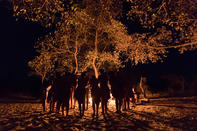Variety of Beliefs
There is a great variety of beliefs among and even within different San groups, but there is also much held in common, even between vastly separated areas.

In the late 19th century, a /Xam (Northern Cape San) man and another from Lesotho independently described their belief in a being named /Kaggen or Cagn. /Kaggen was a combined trickster and creator - powerful and sometimes benevolent, but capable of mischievous, malicious and stupid deeds.
He was thought to have created the eland, the animal which appears most frequently in South African rock paintings. The Kalahari San have a similar trickster figure in their narrative traditions. The Ju/'hoasi described a great and a lesser god, the former associated with life and the rising sun, the latter with death and the west. A belief which was apparently ubiquitously held was that, when the world was first created, animals were indistinguishable from the first people.
These people had not yet acquired culture and manners. Only after a second creation were people and the animals separated, and people learnt how to observe a social code. Certain myths and stories, probably of great antiquity, are also very widely told. Beliefs about death are less uniform. In the late 19th century, the same /Xam man explained that at death a person's heart went into the sky, where it became a star. Among recent Kalahari San too, a shooting star was associated with a person's death. Another southern San belief is that rain-bringing or a bad dry spell at birth is activated again at death.
Rain-making was an important part of southern San religious belief and ritual. The /Xam of the Northern Cape (whose language and cultural unity no longer exist) described 'rain sorcerers', as well as 'game sorcerers' and 'sorcerers of illness' (healers). The religious beliefs known from many diverse San groups are currently thought to be crucial to understanding the rock art of southern Africa.